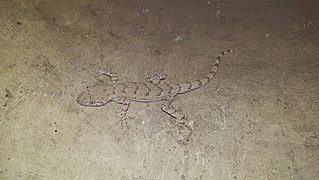
Alsophylax is a genus of small species of geckos, endemic to Central Asia, commonly known as even-fingered geckos. The snout-vent length of these geckos is normally no more than 4 cm (1.6 in). Little is known of their ecology or reproductive habits.

Teratoscincus is a genus of geckos commonly referred to as wonder geckos or frog-eyed geckos; it is the only genus within the subfamily Teratoscincinae of the family Sphaerodactylidae. Species in the genus Teratoscincus are found from the Arabian Peninsula in Qatar, the United Arab Emirates, and Oman, west across southern Asia in Iran, Afghanistan, and Pakistan, north to Russia, Kazakhstan, Turkmenistan, Uzbekistan, and Tajikistan to Mongolia and China. The genus consists of nine species.

Mediodactylus is a genus of Gekkonidae (gecko) family. It contains the following species:

Pristurus is a genus of geckos endemic to Arabia and Socotra Island as well as the Middle East and the Horn of Africa. Species of Pristurus are commonly known as rock geckos .

Tropiocolotes is a genus of geckos, lizards in the family Gekkonidae. The genus is native to North Africa and the Middle East. Species in the genus Tropiocolotes grow to a total length of about 2 in (5.1 cm). They are commonly known as dwarf geckos, pygmy geckos, or sand geckos. They have an elongated body and the head is oval and of equal or lesser width than the body.

The Persian horned viper is a species of venomous vipers endemic to the Middle East and Asia.

The harlequin gecko is a species of gecko, a lizard in the family Diplodactylidae. The species is endemic to Stewart Island/Rakiura in the far south of New Zealand, where it was discovered in 1969. In terms of distribution it is one of the southernmost gecko species in the world.

Cyrtopodion agamuroides, also known by the common names Nikolsky's spider gecko, Nikolsky's Iranian gecko, or the Makran spider gecko, is a species of gecko, a lizard in the family Gekkonidae. The species is endemic to eastern Iran and Pakistan.

Cyrtopodion gastrophole, also known commonly as the Farsian spider gecko, Werner's spider gecko, or Werner's bent-toed gecko, is a species of gecko, a lizard in the family Gekkonidae. The species is endemic to southcentral Iran.

Cyrtopodion kirmanense, also known as the Kirman thin-toed gecko or the Kerman bent-toed gecko, is a species of gecko, a lizard in the family Gekkonidae. The species is endemic to eastern Iran.
The Algerian sand gecko is a species of gecko of the genus Tropiocolotes. It is found in all the Maghreb countries with the exception of Libya.
Microgecko is a genus of geckos, lizards in the family Gekkonidae. The genus is endemic to Asia.
The low lying gecko is a species of lizard in the family Gekkonidae. The species is endemic to western Pakistan.
Microgecko helenae, also known commonly as the banded dwarf gecko, Helen's banded dwarf gecko, Helen's tiny gecko, the Khuristan dwarf gecko, or the Khuzestan dwarf gecko, is a species of lizard in the family Gekkonidae. The species is endemic to western Iran.
Latifi's dwarf gecko, also known commonly as the Zagros tiny gecko, is a species of lizard in the family Gekkonidae. The species is endemic to Iran.
Scortecci's sand gecko, also known commonly as Scortecci's dwarf gecko, is a species of lizard in the family Gekkonidae. The species is endemic to the Arabian Peninsula.
Asaccus tangestanensis is a species of leaf-toed gecko endemic to Iran. This gecko is found in the southern Zagros Mountains in Bushehr Province. It is found in cliffs and caves. The holotype was collected in 2008 and the species is named for Tangestan, the type locality.

Tropiocolotes tripolitanus, also known as the northern sand gecko or Tripoli gecko, is a species of gecko found in northern Africa.

Teratoscincus bedriagai, also known commonly as Bedraiga's wonder gecko or Bedriaga's plate-tailed gecko, is a small species of lizard in the family Sphaerodactylidae. The species is endemic to Central and Western Asia.












